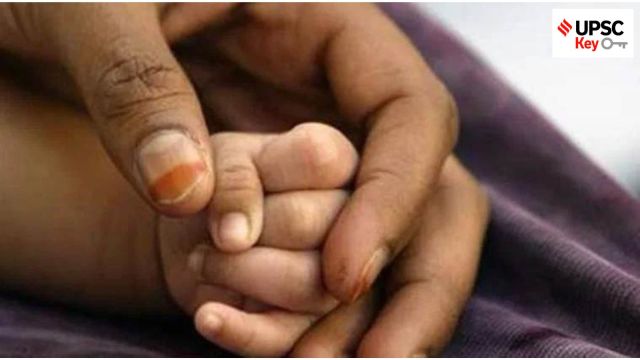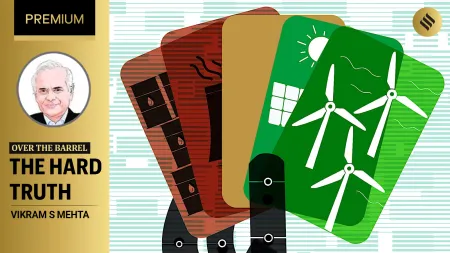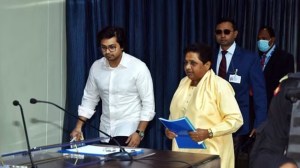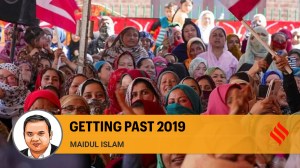- India
- International
UPSC Key | 26th April, 2024 — Model code of conduct, Child care, Intellectual property and more
Exclusive for Subscribers from Monday to Friday: How are Model code of conduct and Intellectual property (IP) relevant to the UPSC Exam? What significance do topics like child care and heat waves have for the preliminary and main exams? You can learn more by reading the Indian Express UPSC Key for April 26, 2024.
 The judgment highlighted that Article 15 of the Constitution not only
restricts discrimination based on gender but also enables the states to
make special provisions for women. Know more in our UPSC Key. (File Image)
The judgment highlighted that Article 15 of the Constitution not only
restricts discrimination based on gender but also enables the states to
make special provisions for women. Know more in our UPSC Key. (File Image)Important topics and their relevance in UPSC CSE exam for April 26, 2024. If you missed the April 25, 2024 UPSC CSE exam key from the Indian Express, read it here.
🚨 The Indian Express UPSC Essentials brings to you the April edition of its monthly magazine. Click Here to read. Share your views and suggestions in the comment box or at manas.srivastava@indianexpress.com🚨
Front Page
Sending notice to party, not candidate, marks shift in EC response
Syllabus:
Preliminary Examination: Current events of national importance, Indian polity and Governance- Constitution, Political System.
Mains Examination: GS-II: Governance, Constitution, Polity, Salient features of the Representation of People’s Act.

What’s the ongoing story- The Election Commission’s first ever notices to political parties for alleged Model Code of Conduct (MCC) violations by their star campaigners marks a significant shift in the institution’s response to such complaints. In the past, the EC has sent general advisories to parties but whenever there is an MCC violation complaint against an individual, the notice goes to the individual rather than the party.
Prerequisites:
— What is the Model Code of Conduct (MCC)? What are the key provisions of the MCC?
— When does the Model Code of Conduct come into effect?
— What restrictions does the Model Code of Conduct impose?
— Read Article 324 of the Indian Constitution and learn about the Election Commission of India.
— Previous Model Code of Conduct ‘Violations’—Know in Brief
Key takeaways:
— In the notices, EC has underlined that individual star campaigners are responsible for their own speeches and the EC may, on a “case-by-case basis,” hold political parties accountable for any MCC violations by their campaigners.
— The change in EC’s stance is more significant against the backdrop of high-profile political leaders who have been served notices directly by the Commission for MCC breaches in the past.
— However, it’s pertinent to note that no sitting Prime Minister, to date, has been issued a notice on a MCC violation complaint.
— According to an EC official, Thursday’s notices are a part of a “calibrated approach” that Chief Election Commissioner Rajiv Kumar had announced during his press conference on Lok Sabha elections on March 16, where tougher actions would be taken against campaigners who are “repeat offenders.”
— “The level of responsibility is not only being raised, but being legally linked to that of the political party to whom the star campaigner belongs. Even political party at the time of their registration with the Election Commission commit to stick to the ideals of the Constitution and we have reminded them about it,” the official told The Indian Express.
For Your Information:
— The MCC of ECI is a set of guidelines issued to regulate political parties and candidates prior to elections. The rules range from issues related to speeches, polling day, polling booths, portfolios, the content of election manifestos, processions, and general conduct, so that free and fair elections are conducted.
— The MCC comes into force from the date the election schedule is announced until the date that results are out.
— The MCC contains eight provisions dealing with general conduct, meetings, processions, polling day, polling booths, observers, the party in power, and election manifestos.
Points to Ponder:
— How Model Code of Conduct evolved over decades?
— Is the Model Code of Conduct legally binding?
— What are the issues associated with the MCC?
— What is the significance of MCC for ensuring free and fair elections?
Post Read Question:
Discuss the role of the Election Commission of India in the light of the evolution of the Model Code of Conduct. (2022)
Other Important Articles Covering the same topic:
Decode Politics: Key to free and fair polls, how Model Code of Conduct evolved over decades
Explained: Model Code of Conduct comes into effect; here’s what that means
Editorial
A collective responsibility
Syllabus:
Preliminary Examination: Current events of national importance, Indian Polity- Constitution, Right Issues.
Mains Examination: GS II: Governance, Constitution, Polity, Social Justice.
What’s the ongoing story- Participation of women in the workforce is a constitutional entitlement and denying mothers child care leave violates this, the Supreme Court said Monday. A bench of Chief Justice of India D Y Chandrachud and J B Pardiwala was hearing a plea by an assistant professor in the Government College, Nalagarh, who was denied childcare leave (CCL) to attend to her child suffering from a genetic condition.
Prerequisites:
— What are the articles of the Indian Constitution related to gender equality and women?
(Thought Process: Read articles 14, 15, 16, 21, 39, 39(A), 42, 51 A (e), Reservation of Seats for Women in Panchayats and Municipalities.)
— What is the status of women in India?
— What is the provision with regard to child care leave in India?
Key takeaways: Sudeshna Sengupta, Chirashree Ghosh writes-
— “Women government employees are eligible for two years of CCL for two children till they reach the age of 18 years.”
— “The judgment highlighted that Article 15 of the Constitution not only restricts discrimination based on gender but also enables the states to make special provisions for women.”
— “In a country where care is perceived as the responsibility of women, the verdict makes it clear that the state and the employer have responsibilities to enable women to join and retain their employment.”
— “In India, women have little choice but to single-handedly manage the triple burden of housework, care work and paid work….”
— “Working women often face “marriage penalties” and “motherhood penalties” as they are often temporarily forced to withdraw from the workforce due to marriage and pregnancy. It is no surprise that the female workforce participation in India is barely 37 per cent.”
— The Constitution enables the state to make special provisions for women and children. The sectoral labour laws that were repealed recently after the introduction of four Labour Codes mandated childcare services on worksites and paid maternity leaves for a section of workers at construction sites, beedi, cigar and other factories, plantations and migrants. These laws mandated crèches on worksites that had a stipulated number of women on the work site.”
— “The provision went through a transformation under the Labour Code on Social Protection, 2020, where crèches were made a gender-neutral entitlement. It is a significant step in the right direction. The gender-neutral provision underlined care as a “parental” responsibility…”
— Care needs to be seen as a collective responsibility of the state, employers, and communities. Labour markets need to consider women as primary earners and enable them to take up full employment. There is evidence of high female labour force participation in countries where unpaid care work responsibilities are equally shared.
For Your Information:
— “As per PLFS 2022, 60 per cent women are self-employed and 53 per cent of the self-employed women work as unpaid family helpers. These are intertwined outcomes of lack of opportunities in the labour market and opting for flexible employment near or at home to balance both.”
— “A decrease in women’s unpaid care work is related to a 10-percentage point increase in women’s labour force participation rate. The IMF has predicted a possible alleviation of 27 per cent in India’s GDP through an equal participation of women in the labour force participation.”
Points to Ponder:
— What is the National Crèches Scheme?
— What is the Palna Scheme of the Mission Shakti project?
— What are the government’s initiatives for promoting women’s empowerment?
— What are the issues related to women?
Post Read Question:
What are the continued challenges for Women in India against time and space? (2019)
Other Important Articles Covering the same topic:
SC: Denying women child care leave is violation of Constitution
UPSC Key | 23rd April, 2024 — Abortion law, semiconductor, child care leave and more
Health on a hot planet
Syllabus:
Preliminary Examination: General issues on Environmental Ecology, Biodiversity and Climate Change – that do not require subject specialisation.
Mains Examination: GS-III: Conservation, environmental pollution and degradation, environmental impact assessment.
What’s the ongoing story- K Srinath Reddy writes- A study of 266 studies worldwide, published in 2022, revealed that heat waves were associated with a 11.7 per cent increase in mortality. The highest specific risk was for stroke and coronary heart disease.
Prerequisites:
— What are heatwave and heatstroke?
— What is pulmonary embolism?
— What are the extreme weather conditions?
Key takeaways:
— K Srinath Reddy writes- “the consequences of climate change, mostly mediated through global warming, adversely affect human, animal and plant health in several ways: Direct effects of heat exposure on the body; extreme weather events; water scarcity; vector-borne and water-borne infections…”
— “The India Meteorological Department (IMD) says that such “moist heat” stress has increased by 30 per cent between 1980 and 2020.”
— “Heat acts through dehydration, inability of the skin to cool the body through perspiration, dilatation of blood vessels and thickening of blood with increased risk of clot formation (thrombosis).”
— “Infants and young children are more vulnerable than adults, since their bodies have higher fluid content than grownups. Among adults, vulnerability is high among the elderly, persons with disabilities and in those with serious comorbidities. Women are more vulnerable than men.”
— “Non-communicable diseases (NCDs) contribute to 65 per cent of deaths in India. The heat effects of climate change will only exacerbate the problem.”
— “As our population ages and cardiovascular risk factors rise in our population, every 1 degree centigrade rise in ambient temperature will compound the risk of serious cardiovascular events.”
— “Wildfires triggered by excessive heat release particular matter and toxic chemicals in the environment. It can cause an increase in the risk of cardiovascular diseases and cancer.”
— “Less immediate, but with a long lasting impact on health, is the impact on food systems which threatens nutrition security. Countries in South Asia and sub-Saharan Africa currently grow staples (like rice and wheat) at the highest levels of heat tolerance. A further increase of 1 degree centigrade will lower their yield by 10 per cent. The crops will also be more deficient in zinc, protein and iron.”
— “Rising ocean temperatures will flood coastal agriculture while reducing fish yields. Loss of biodiversity will reduce access to nutritious “wild foods”. Heat will kill us not only through its effect on our skin but also our stomachs.”
— “There is a need to prepare for adaptation plans. These will include heat action climate-smart and climate resilient food and healthcare systems, and education of public and healthcare providers…”
For Your Information:
— According to the World Meteorological Organisation’s State of the Climate Asia report, Asia faced the most disasters in the world as 79 events associated with extreme weather, climate, and water-related hazards in 2023 affected over nine million people in the region, directly killing over 2,000 people.
— Heatwaves, floods and landslides took a heavy toll on life in India. The people living in coastal areas, mountainous regions, even the plains are all vulnerable to climate vagaries.
— The time has come to develop mechanisms of cooperation that will enable people — and cities and towns — to be resilient against climate change. Natural phenomenon rarely respects national boundaries. And, large parts of Asia, especially South Asia, have ecological continuities that make the case for joint work on building defences compelling.
Points to Ponder:
— Is heatwave recognised as a natural disaster in India?
— What are the criteria for declaring a Heat Wave in India?
— Impact of heatwave on labour productivity
— Role of the international organizations to counter extreme weather events
— Impact of heatwaves on developed and developing countries
— What health initiatives need to be taken at national and international levels to combat the impact of heat waves?
Post Read Question:
Discuss the impact of heatwave on food security and human health. Also, provide the way forward.
(Thought Process: Mention the nexus of the heatwave, health, and food security–cite data from WMO and ILO–need for international collaboration in climate resilient agriculture to ensure food security–recognizing heatwave as ‘natural disaster’-adoptive measures from individual level to international level.)
Other Important Articles Covering the same topic:
UN warns India of loss of productivity due to global warming
Explained
Rise of a ‘new’ Japan
Syllabus:
Preliminary Examination: Current events of national and international importance
Mains Examination: GS-II: International Relations, Effect of policies and politics of developed and developing countries on India’s interests,
What’s the ongoing story- Japan has given up its post-War pacifism and is working to become a major military power. The turn is historic, and promises to transform the geopolitics of Asia and the world. A politically resolute and militarily strong Japan contributes to India’s objective of building a multipolar Asia in a multipolar world.
Prerequisites:
— What is the concept of pacifism?
— What is the bilateral military alliance between Japan and the United States?
— What do you understand by the concept of Indo-Pacific? What is the significance of the Indo-Pacific?
Key takeaways: C. Raja Mohan writes-
— “After World War II, a defeated and chastened Japan adopted a policy of pacifism — it avoided building significant armed capability, limited its defence expenditure, and refused to participate in military conflicts anywhere.”
— “Japan’s pacifism was compensated by its bilateral military alliance with the United States. Being a protectorate of the US in Asia, Japan was free to focus its energies on rebuilding its economy.”
— Today, Japan is set to become a major military power, transform its famed civilian industrial capability into a military industrial complex, and turn from being a US protectorate into an American partner and a significant contributor to Asian and Indo-Pacific security.
— This is the second Japanese transition over the last decade. “In the mid-2000s, Japan began to articulate ideas for a new security architecture in Asia. Take for instance the concept of the Indo-Pacific….”
— “In the second transition unfolding today, Japan is matching its strategic ideas with military resources and the political will to actively reshape the regional security order. Kishida’s visit to Washington DC was in effect the unveiling of a new geopolitical Japan.”
— Reasons behind the radical change in Japan’s reorientation in defence: “A mix of external and internal factors have contributed to its (Japan’s) reorientation in the 21st century. On the external front, four elements have come together: the rise of China and its military assertion, especially on the territorial disputes with Japan; the deepening military bonds between Beijing and Moscow and the coordination of their policies in North East Asia; the growing military capabilities of North Korea; and the fears triggered by the Trump Administration that the US could withdraw its security protection to Japan and other Asian allies…”
— “Internally, this situation strengthened conservatives in Tokyo, who wanted to see Japan becoming a ‘normal power’. They argued that Japan has done enough to prove its credentials as a responsible citizen of world affairs, and the time has come for it to take responsibility for its own security, and to contribute to the regional order.”
—What Japan is doing to become a geopolitical power? : First, Japan has done away with the historical cap on defence expenditure, Second, Japan has acquired, and is in the process of further acquiring, its own counter-strike capability in the form of cruise missiles, Third, late last year, Japan’s cabinet eased its self-imposed ban on exports of lethal weapons to friendly countries, Fourth, Japan and the US are in the process of revising the command-and-control framework governing their defence forces, with plans to eventually significantly integrate the command structure.
— “a politically resolute and militarily strong Japan that can build a stable Asian equilibrium is a positive development from the Indian perspective. It contributes to India’s objective of building a multipolar Asia in a multipolar world.”
Points to Ponder:
— Have there been changes in Japan’s diplomatic posture?
— How has India reacted to this change in Japanese policy?
— What are the implications of this ‘new’ Japan?
— What is the Global Combat Air Programme?
— What is the state of India-Japan relations? What are the challenges in the path of strengthening India-Japan ties?
Post Read Question:
“After decades of pacifism, a politically active and militarily more capable Japan will inevitably rearrange the regional security calculus.” Analyse.
Other Important Articles Covering the same topic:
Why Japan-US summit holds promise for India
India, Japan discuss developments in areas of disarmament, non-proliferation
How American universities have long been hotbeds of protest
Syllabus:
Preliminary Examination: Current events of national and international importance
Mains Examination: GS-I, History of the world will include events from the 18th century such as industrial revolution, world wars, redrawal of national boundaries, colonisation, decolonization, political philosophies like communism, capitalism, socialism etc.— their forms and effect on the society.
What’s the ongoing story- College campuses across the United States are on the boil as students and other agitators have been critical of the Israel-Hamas war and the humanitarian situation in Gaza. There is increased tension at several US campuses after days of pro-Palestinian protests that have triggered mass arrests and shut down classes.
Prerequisites:
— What is the issue of Israel and Palestine?
— What is Greensboro sit-in?
— American Civil Rights Movement
— The Black Lives Matter movement
— What is the anti-apartheid movement?
Key takeaways:
— It gives a brief history of student protests in America. It includes the protest during the US’s war in Vietnam, Greensboro sit-ins (against a backdrop of continued black frustration with Greensboro’s racist policies- culminated with the passage of the Civil Rights Act in 1964), and mass student strike after the Ohio National Guard opened fire on May 4, 1970. The protestors were demonstrating against the further expansion of the United States’ campaign into Cambodia.
— According to historian Gerard De Groot, “Students are often at the cutting edge of social radicalism. They alone possess the sometimes volatile combination of youthful dynamism, naive utopianism, disrespect for authority, buoyant optimism and attraction to adventure, not to mention a surplus of spare time.”
— After the 1960s, the next major protests on US campuses were against South Africa’s apartheid regime. These protests spread from South African schools to the United States. The protests were crucial for administrators to withdraw billions of dollars of investments from companies tied to South Africa.
— In the mid-2010s, campuses saw heated protests during the Black Lives Matter movement. It led the student government to cut off funding for the campus newspaper. In Columbia, these protests prompted the university to drop its investments in private prisons in 2015.
For Your Information:
— On questions on protests at Columbia University and Universities in the US, the Indian Ministry of External Affairs’ official spokesperson Randhir Jaiswal said, “In every democracy, there has to be the right balance between freedom of expression, sense of responsibility and public safety and order.”
— “Democracies in particular should display this understanding in regard to other fellow democracies. After all, we are all judged by what we do at home and not what we say abroad,”
— The annual report of the US State Department, the 2023 Human Rights Report, highlighted “significant” abuses in the northeastern state of Manipur where an ethnic conflict broke out last year. It also mentioned the alleged attacks on minorities, journalists, and dissenting voices across the country.
— The MEA responded with the statement that “this report is deeply biased and reflects a poor understanding of India. We attach no value to it and urge you to do the same.”
Points to Ponder:
— History of the anti-apartheid movement, civil rights movement, and Black Life Matters
— Significance of civil society in strengthening democratic fabrics
— India and US relation on the question of human rights violation
Post Read Question:
“In every democracy, there has to be the right balance between freedom of expression, sense of responsibility, and public safety and order.” Comment.
Other Important Articles Covering the same topic:
India, US regularly consult at highest levels on democracy, human rights issues: Official
50 yrs of portugal’s Carnation Revolution: How Europe’s longest dictatorship was overthrown
Syllabus:
Preliminary Examination: Current events of national and international importance
Mains Examination: GS-I, History of the world will include events from the 18th century such as Industrial Revolution, world wars, redrawal of national boundaries, colonisation, decolonization, political philosophies like communism, capitalism, socialism etc.— their forms and effect on the society.
What’s the ongoing story- Thousands spilt on to the streets on Thursday (April 25) to celebrate the 50th anniversary of Portugal’s ‘Carnation Revolution’ that toppled the longest fascist dictatorship in Europe and ushered in democracy in the country.
Prerequisites:
— What do you understand by the term ‘colonisation’?
— What do you understand by ‘far right’ and ‘far left’?
— What is ‘decolonisation’?
Key takeaways:
— The almost bloodless revolution was conducted by a group of junior army officers who wanted democracy, and to put an end to long-running wars against independence movements in the African colonies of Angola, Mozambique, and Guinea-Bissau.
— The military coup by the “April’s Captains” group touched off rapid decolonisation, ending more than five centuries of the Portuguese empire in Africa.
For Your Information:
— President of Portugal Marcelo Rebelo de Sousa has said that Portugal was responsible for crimes committed during transatlantic slavery and the colonial era, and suggested there was a need for reparations.
Points to Ponder:
— Impact of colonialism on the erstwhile colonies
— How colonisation impacted the economy of India and Africa?
— Portugal empire in India
Post Read Question:
What is the long-term impact of decolonisation in the African continent?
(Thought process: Build on the colonisation– the transatlantic slave trade, scramble for Africa–the process of decolonisation–the impact of colonisation on Africa’s economy–civil war and unrest in recent times)
Other Important Articles Covering the same topic:
UPSC Key | 25th April, 2024-Carnation Revolution
Economy
Target is to achieve $1 trillion goods exports by 2030: Trade Ministry
Syllabus:
Preliminary Examination: Economy
Mains Examination: GS-III: Indian Economy and issues relating to planning, mobilisation, of resources, growth, development, Infrastructure: Energy, Ports, Roads, Airports, Railways etc.
What’s the ongoing story- The commerce Ministry has initiated an exercise to identify required infrastructure needs, potential sectors, and clusters which would help the country achieve the $1 trillion merchandise exports target by 2030 but sustainability will be a major concern going forward, senior government officials said on Thursday.
Prerequisites:
— What are India’s top export and import products?
— What is the corporate sustainability due diligence directive?
— What is carbon border adjustment mechanism (CBAM)? How can it impact India?
— International Institutions/Forums to look for:
(i) European Union
(ii) Asian Development Bank (ADB)
(iii) World Trade Organization
Key takeaways:
— This comes a day after the European Parliament voted on Wednesday for a new law that will require larger companies operating in the bloc to check if their supply chains use forced labour or cause environmental damage and act to take action if they do.
— Prior to CSDDD, the European Union enforced the carbon border adjustment mechanism (CBAM), another environment related law that penalises products with high carbon footprints coming into the 27-member bloc.
— “In most major economies, sustainability issues will be a major concern. So how do we reduce our carbon footprint and how do we gear up our entire infrastructure to sustainably move goods and packaging is something that our business and trade needs to work on,” Santosh Sarangi, Director General, Directorate General of Foreign Trade, said at the CII conference on logistics.
— Sarangi said that the government is also focusing on ways to push India’s integration into the GVCs as at present about 70 per cent of the global trade is happening through these chains. He further said that an infrastructure push is required at ports and airports to increase India’s exports and to handle $2.5 trillion of exports and imports, India needs to create a lot of infrastructure,
Points to Ponder:
— What is India’s Foreign Trade Policy, 2023? What are its main components?
— What is the status of Indian exports sector?
— What are the factors that affect the India’s export sector?
— What are the challenges associated with the export sector in India?
Post Read Question:
What are the initiatives taken by the government for the growth of merchandise exports?
Other Important Articles Covering the same topic:
Express View on new trade policy
IP issues: USTR places India on priority watch list
Syllabus:
Preliminary Examination: Current events of national and international importance
Mains Examination: GS-III, Awareness in the fields of IT, Space, Computers, robotics, nano-technology, bio-technology, and issues relating to intellectual property rights.
What’s the ongoing story- India remains “one of the most challenging” major economies with respect to the protection and enforcement of intellectual property, Biden Administration said on Thursday as it placed the country on the Priority Watch List on its 2024 Special 301 Report.
Prerequisites:
— What is Intellectual Property (IP)?
— What is a trademark?
— What is the Special 301 Report?
— What is USTR?
— What is the India- United States Trade Policy Forum (TPF)?
Key takeaways:
— India along with Argentina, Chile, China, Indonesia, Russia, and Venezuela have been placed on the 2024 Special 301 Report on the adequacy and effectiveness of US trading partners’ protection and enforcement of intellectual property (IP) rights released by the US Trade Representative.
— While there has been progress under the US-India Trade Policy Forum in addressing certain issues with trademark infringement investigations and pre-grant opposition proceedings, numerous long-standing concerns remain, the USTR report said.
Do you know?
The World Intellectual Property Day is celebrated on April 26. The theme of this year is IP and the SDGs: Building our common future with innovation and creativity.
Points to Ponder:
— Which International body looks after the protection of Intellectual Property?
— What are the different types of Intellectual Property Rights?
— What is the rank of India in the International Intellectual Property Index?
— What is the intellectual property-related agreement of the WTO?
— Issues related to Intellectual Property Rights in India
— Initiative of the Indian government to make a robust intellectual property right
Post Read Question:
Prelims
Who releases the International Intellectual Property Index?
(a) World Intellectual Property Organisation
(b) US Chamber of Commerce
(c) World Trade Organisation
(d) World Economic Forum
Mains
What do you understand by ‘Intellectual Property Rights’? Why a country needs to have a good IPR regime?
Other Important Articles Covering the same topic:
India ranks 42 out of 55 in International Intellectual Property Index
UPSC Essentials: One word a day- Intellectual Property Rights (IPR)
UPSC Ethics and Essay Snippet
“Wordly Wise” from The Editorial Page
“The Climate emergency is a race we are losing, but it is a race we can win.” -Antonio Guterres
(Thought Process: The WMO’s ‘State of the Climate Asia’ report presents an alarming state of climate change in Asia. This calls for an immediate international collaboration but the time has come to develop mechanisms of cooperation that will enable people — and cities and towns — to be resilient against climate change. Natural phenomenon rarely respects national boundaries. And, large parts of Asia, especially South Asia, have ecological continuities that make the case for joint work on building defences compelling. Elaborate.
Refer to the Editorial Page: Why a hotter world is more dangerous for India.)
Subscribe to our UPSC newsletter and stay updated with the news cues from the past week.
May 07: Latest News
- 01
- 02
- 03
- 04
- 05





































